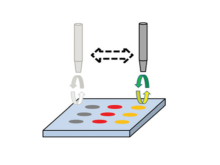BACKGROUND
Pathogen detection is important to such applications like environmental monitoring, clinical diagnostics and biological agent recognition. Most detection methods are very specific and focus on identifying the particular strain of bacteria or virus. However, in applications such as lake or drinking water testing the general monitoring of overall pathogenic load may be better suited to identifying a contaminated water source and preventing sickness. To this end, pathogen-associated molecular patterns (PAMPs) which are small molecular motifs conserved within a class of microbes and recognized by toll-like receptors (TLRs), may serve as general, broad-spectrum identifiers of pathogenic presence or load when detected in important environmental samples.
TECHNOLOGY
Inventors at the University of Toronto have designed and demonstrated a simple broad-spectrum bacterial biosensor. The microarray sensor consists of three different toll-like receptors (TLR 1, 4 and 5) deposited onto a chip, and surrounded by a plating of certain ferrocene derivatives. Binding of the diagnostic bacterial markers, namely triacylated lipopeptides, lipopolysaccharides and flagellins to the TRLs, produces a differential electrochemical signal that can be interpreted by a variety of different electrochemical detectors (e.g. scanning electrochemical microscopy, cyclic voltammetry) (Figure 1). The ferrocene layer is key to enhancing the signal to noise ratio and in lowering the detection limit. The chip has a flexible configuration where several different TLR recognition elements and deposition patterns can be combined to fine-tune the sensor for a particular use or electrochemical detection system.
Figure 1. A ferrocene coated gold chip (light blue) with three different toll-like receptors deposited on the surface for sensing bacterial signatures. Binding of a ligand induces a change in the electrochemical properties (yellow/green arrows) compared to a reference (grey arrows) enabling detection of bacterial species when coupled to a readout.
COMPETITIVE ADVANTAGE
- Robust detection technique for pathogenic presence or load in contaminated water samples
- Ferrocene plating surrounding the TLR detection elements significantly improves sensitivity
- Microarray recognition elements are customizable and are not limited to toll-like receptors (TLRs)
APPLICATIONS
- Pathogen detection
INTELLECTUAL PROPERTY
- Granted Patents: USA and Canada (US10794932B2; CA3034534C)
PROJECT STATUS
Sensor microarrays have been developed and shown to detect E. coli K12 using scanning electron microscopy (Figure 2). Further studies demonstrated the potential for general electrochemical detection. In these studies, a synthetic PAMP was detected using cyclic voltammetry and electrical impedance spectroscopy.
Figure 2. Detection of E. coli using a sensor microarray with three different toll-like receptors (TLR1, 4 and 5) and a scanning electron microscopy detector. An increase in current is observed in the presence of E. coli enabling detection.





